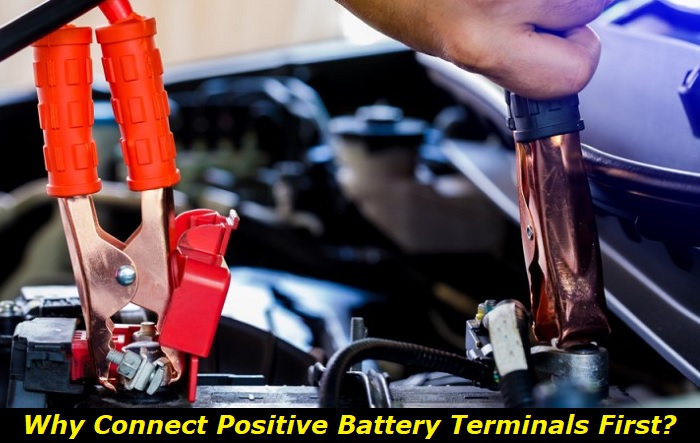When removing the battery from a car, it's often said that you should remove the positive terminal first. Is this just an automotive myth or is it actually a good piece of advice? As it turns out, it's solid advice with a very good reason behind it.
Dead car battery replacement highlights
- Critical voltage:less than 10 volts
- Average battery age:4-5 years
- Tools needed:set of wrenches
- Timeneeded:15 minutes
- If done incorrectly:electronic glitches, frying ECU, no crank-no start
- DIY fix:possible
- How much to fix?$150 - $250

Order to Connect Battery Terminals
Car batteries store high amounts of electrical and chemical energy, so it is important to know how to handle them properly. Here we'll discuss the proper way to safely install a battery in your car, as well as how to safely remove your battery.
- How to Connect a Battery to Your Car
When connecting the battery to your car, you need to connect the positive terminal first. This prevents a short circuit from occurring if your wrench should touch the metal frame of the car.
If you connect the negative terminal first, then the battery will be grounded to the metal frame of the car. A short circuit could occur if the wrench connects the terminal and the metal frame of the car. This could result in sparks or even a battery explosion.
The safest way to connect a car battery is to make sure that the negative terminal is connected last. This prevents short circuits from occurring.
- How to Disconnect a Battery from Your Car
When disconnecting the battery from your car, the same considerations as above apply. However, the order of disconnecting the terminals is the reverse order of connecting terminals. This means that the negative terminal should be disconnected first, and the positive terminal should be disconnected last.
If the positive terminal is disconnected first, then there's a risk of a short circuit occurring if the wrench touches the frame of the car while trying to remove the negative terminal.
1. Taking Short Drives Kills the Battery
It might seem counterintuitive but driving your car for short distances is not good for the battery life. At first, this seems not to make sense. After all, wouldn't use the battery for less time result in less wear? While this is generally true, it does not apply to batteries in this instance.
Operating your car requires a lot of electricity from the battery. When the engine runs, it turns the alternator which generates electricity to charge the car's battery. If the car is driven for more than 30 minutes, the alternator will have generated enough electricity to increase the charge in the battery. If the engine runs for less than 30 minutes, however, the alternator will not have had enough time to replenish the energy the battery used in starting the car.
Driving for less than 30 minutes consistently results in the battery losing charge. If the battery is left with a low charge for too long, its lifespan will be reduced.
If you only need your car for short drives, then you should consider taking your car on longer drives occasionally. You can also take the car to a well-ventilated area and allow the engine to run for more than 30 minutes. Doing this a few times a week will allow the battery to stay charged.
2. Protect Your Terminals with Petroleum Jelly
Battery terminals commonly develop corrosion through exposure to moisture in the air. Corrosion interrupts the electrical contact between the battery and the car, resulting in reduced voltage and an unreliable connection.
You can use petroleum jelly or dielectric grease to strengthen the contacts between the battery and the connectors. These materials will also seal the connection from air and water to prevent corrosion.
3. Don't Leave Your Battery Unused in the Car
Try to avoid letting your car sit unused for long periods. This isn't good for the battery's health and can cause buildup inside the battery that reduces its power and prevents it from holding a charge.
If you don't have any reason to drive your car often, try to start the car and leave the engine running for about 30 minutes one or two times a week. This allows the battery to discharge and recharge, which keeps it in good condition.
If you must travel or you won't be near your car for an extended time, then remove the battery from the car and store it in a cool dry place. This will prevent the car from discharging the battery and will keep the battery in good condition until you're ready to drive it again.
4. Always Lock Your Car Doors
As the years have gone by there have been many advances in automotive technology. Newer car models contain a lot of technology that runs in the background. All of these systems demand a lot of power from the battery.
Normally when the engine is running, these systems won't drain the battery directly. However, some of these systems will keep running after the engine is turned off. As a result, they will drain the battery directly, which will drastically shorten the life of the battery.
The background systems in newer cars will shut off once the engine is turned off and the doors are locked. To fully shut down your car after parking, make sure to lock the doors, even if the car is securely parked inside your garage.
5. Store your key away from the car
A convenient feature of modern cars is the keyless entry system. These cars come with key fobs that you simply need to carry inside the car with you to allow you to start it. The car and the key fob communicate using a radio signal that lets the car know if the key fob is in range.
For most cars, the communication range between the car and the key fob is about 5 meters. The key fob in the car will continue to communicate for as long as the key is in range. This happens even if the engine is off, which results in the car's radio communication module staying awake. This drains the car's battery.
A simple solution to this is to make sure that you don't store your key fob inside or within 5 meters of the car. If you want to keep the key within 5 meters of the car, then make sure to store the key fob inside an RF-blocking bag or Faraday bag, which blocks radio signals.
6. Keep Your Battery Warm with A Battery Blanket
You might have noticed that your car has a hard time starting in cold weather. While this could be a result of the engine being cold, in many cases it's caused by the effects of cold weather on the battery.
Car batteries work by converting electric chemical energy to electrical energy. Cold weather can cause the chemicals in the battery to freeze up, slowing down the chemical reactions. This results in hard starting.
To prevent this from happening, you can use a battery insulation blanket to keep your battery warm even in cold weather.
7. Clean Your Battery Terminals
While some car batteries are labeled as maintenance-free, they all still require some degree of maintenance to stay in good condition. Car battery terminals should be cleaned to prevent the build-up of rust and corrosion.
To clean your battery terminals, remove it from the vehicle. Then make a paste with some baking soda and water and apply it to the terminals. Make sure to apply it to only one terminal at a time to avoid bridging the terminals.
Allow the baking soda to sit for a few minutes, then use a toothbrush or a wire brush to scrub the corrosion off the contacts. Rinse the contacts clean and allow the battery to dry off.
Conclusion
A car battery isn't a thing that you can just put inside your car and forget. Maintaining good battery health and safety requires a combination of proper knowledge and good habits. Connecting the positive terminals first when installing the battery is a safety measure that prevents short circuits and battery explosions.
There are many other battery secrets that drivers should know, such as not taking short drives, not leaving the battery unused in the car, and making sure the key fob isn't stored too close to the car.
Some basic battery care like using a battery insulator, applying dielectric grease to the contacts, or cleaning your battery will also protect your battery from corrosion and damage.
Following these tips will ensure that your car battery lasts its full lifetime.
About the authors
The CarAraC research team is composed of seasoned auto mechanics and automotive industry professionals, including individuals with advanced degrees and certifications in their field. Our team members boast prestigious credentials, reflecting their extensive knowledge and skills. These qualifications include: IMI: Institute of the Motor Industry, ASE-Certified Master Automobile Technicians; Coventry University, Graduate of MA in Automotive Journalism; Politecnico di Torino, Italy, MS Automotive Engineering; Ss. Cyril and Methodius University in Skopje, Mechanical University in Skopje; TOC Automotive College; DHA Suffa University, Department of Mechanical Engineering






Add comment